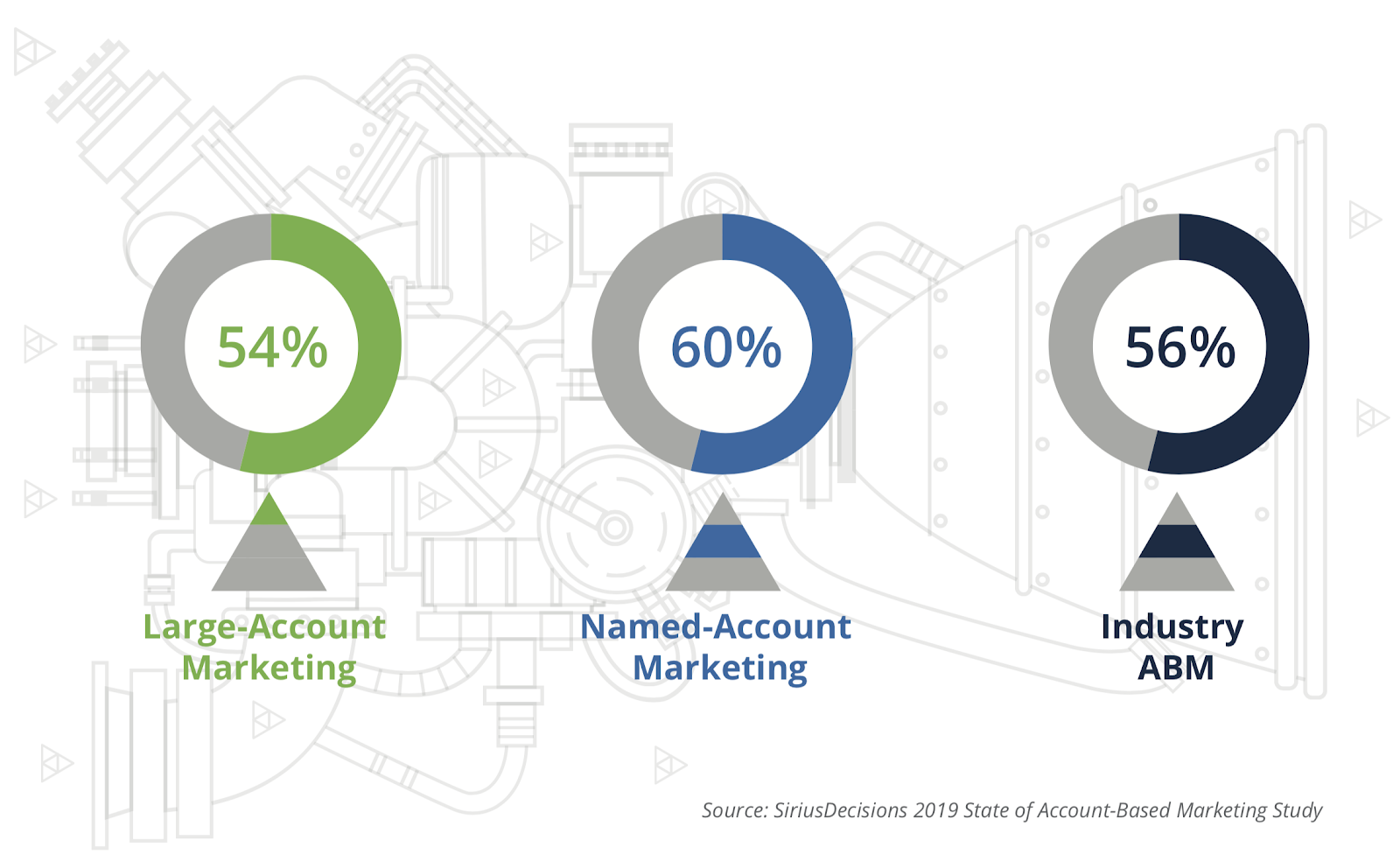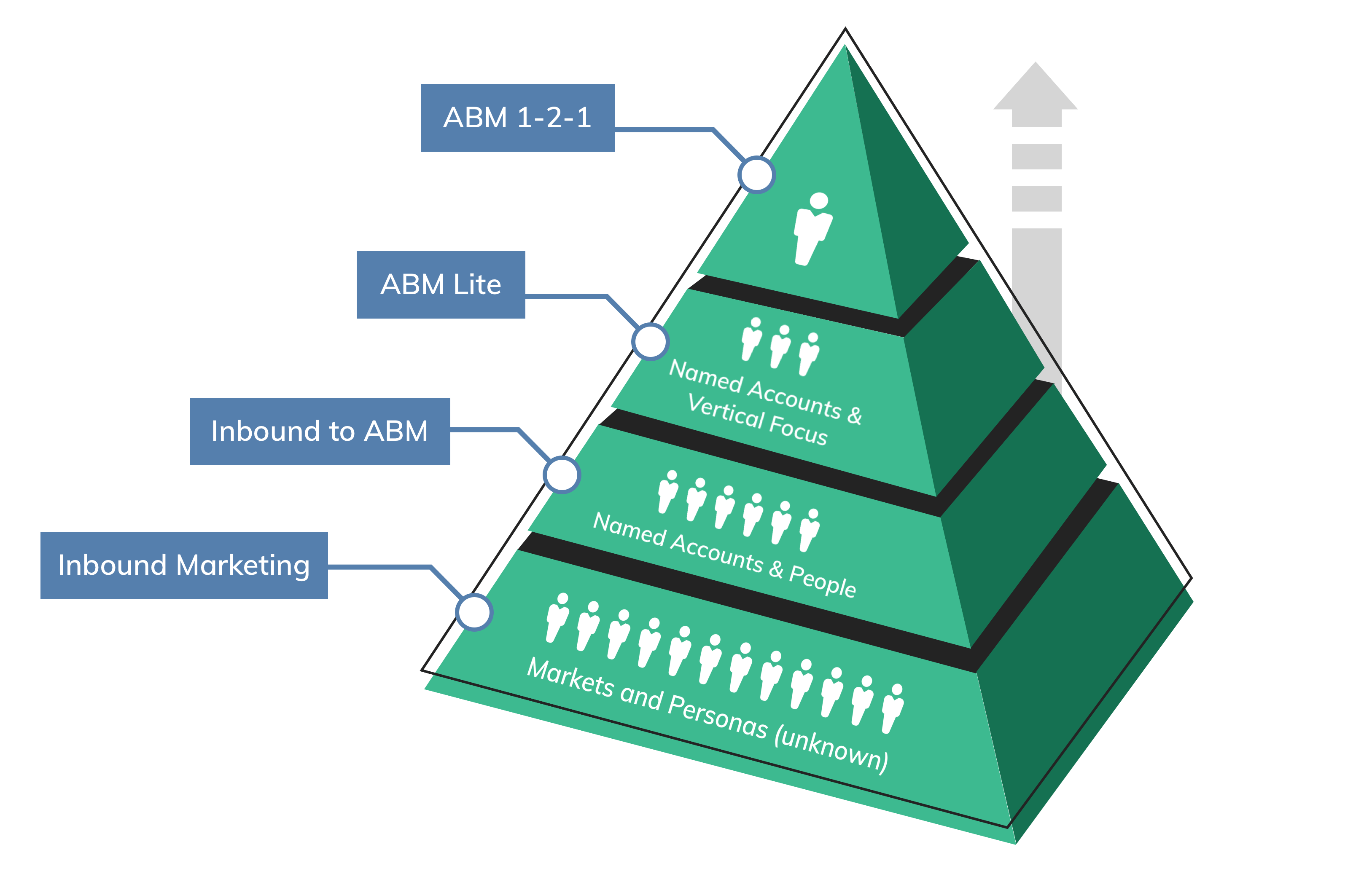We look at key takeaways from the 2019 Sirius Decisions report ‘The State of the Account-Based Marketing Revenue Engine’ detailing key thoughts, takeaways and considerations for success in the future.
The State of ABM in 2019
2019 has been in many ways the “tipping point” for the perception of ABM as a crucial and effective strategy for B2B marketers. As a concept, modern ABM in B2B has moved from the realm of a ‘nice to have’ strategic consideration, to a more mainstream approach, that many marketers now recognise as a key method to drive profitability, growth and strong relationships with high priority customer accounts.
According to Sirius Decisions’ recent report, “The State of the Account-Based Revenue Engine 2019”:
B2B sales and marketing leaders recognise that a well-functioning revenue engine is a key driver for profitability and growth. They also understand the value of designing parts of that revenue engine around their high-priority accounts.
This is why account-based marketing (ABM) programs continue to grow, fuelled by the delivery of strong results, including higher account engagement, improved win rates, larger average deal size and strong ROI.
This popularisation is both the result and cause of increasing investment by businesses. Buoyed by the higher win rates, greater engagement, bigger deals and clearer ROI that ABM programs can bring, B2B organisations are increasingly keen to allocate budget to these kinds of strategies.
Of course, with increased investment comes a greater requirement for ABM marketers to provide comprehensive, end-to-end measurement in order to fully demonstrate and deliver ROI.
But even as ABM programs increase in popularity among B2B organisations and deliver significant business results, ABM leaders must be able to justify greater investment by providing comprehensive measurement to show the programs’ impact.
So how are teams approaching ABM Marketing in 2019? What challenges and issues are organisations facing, and where should teams focus their efforts?
Below are five key takeaways from the Sirius Decisions ‘State of the Account-Based Revenue Engine 2019’ report plus our own thoughts on the existing state of ABM, and how to drive future success.
5 Key Takeaways from the “The State of ABM”
1. Acquiring and prioritising relevant data in the account selection process is still a key challenge for many organisations
There is no one-size-fits-all approach when it comes to ABM campaigns, account selection, and the data acquisition that informs it. This is, in many ways, a blessing and a curse. It allows for a necessary level of flexibility in approach, but also requires a considered, case-by-case understanding across campaigns, of exactly how to define and prioritise a target account.
This is supported in the Sirius Decisions findings, as “deployment model sets parameters for the number of accounts in the program, level of insights required, proposed level of customisation, and resourcing requirements… many organisations use more than one ABM model, often piloting one type and then broadening the ABM scope.” In the image below, which shows popular deployment types, ABM models are defined as:
- Large Account: a small number of large existing or targeted accounts (a.k.a ABM 1-2-1)
- Named Account: A moderate or larger number of defined existing or targeted accounts. (a.k.a ABM Lite/ ABM 1-2-Few)
- Industry/Segment: A moderate or larger number of new or existing accounts in the same vertical or other similar segment. (a.k.a ABM Lite or ABM 1-2- Many)

Understanding the level of insight required at, say, an ABM Lite/Named Account stage vs. other account marketing stages is also important, especially when evaluating why and how an account should progress from one ABM model to another - i.e. with the approach becoming more focussed and personalised as it progresses.

What does this mean for future ABM campaigns?
Ultimately, we can only see this heading in one direction, and that is towards the greater use and uptake of considered insight; such as in-depth insight reports (which are used to achieve a greater understanding of your specific market, audience or accounts ahead of campaign development) - combined with buyer intent data from a range of sources.

If ABM campaigns are the bow and arrow of a B2B marketing strategy, intent data is like adding a military-grade scope and sight! Of course, it is possible to run ABM programmes without intent data. But as intent data provides clarity into those accounts who are actively-in market for solutions, why not maximise ABM campaign potential with an informed approach to account selection and prioritisation?
The future of ABM as a widely-accepted strategy will rely on ever-increasing accuracy, and that’s something that only intent data will bring.
2. Resourcing ABM programmes can be tricky
When resourcing ABM, having a balance of experience and industry knowledge is a must.
Having sales & marketing aligned on the same goals and objectives is a great start as sales can bring a lot of that industry and customer knowledge to the table.
Bringing in external expertise can also help to accelerate learnings, drive the programme forward and align stakeholders, as often marketers may not have as much experience in working with the sales team or understanding their drivers.
What does this mean for future ABM campaigns?
Of course, adequate resourcing requires adequate budget.
According to the Sirius report, the average enterprise ABM budget is $350,000, and that’s excluding headcount costs. However, at Strategic, we are developing programmes for clients at the $150k range and pilot projects from $35,000 - so you need to consider the budget in terms of starting point and the level of maturity within an organisation.
As 70% of organisations expect that average budget amount to increase over the next 12 months as programmes mature; taking a considered approach to resourcing - and working with a team to understand the best ways to return value on that budget - is increasingly important.
“For ABM to succeed, it needs to be appropriately resourced. Proper resourcing requires not only the right people and the required skills, but an appropriate budget.”
3. A focus on KPIs and commercial outcomes is a must
As there are many moving parts within ABM programmes, having clear KPIs to monitor, helps to keep everyone focussed on the important numbers.
ABM is, and always has been, about clear and demonstrable return on investment - the kinds of budgets required to activate a campaign are not the sort of money that can be frittered away on a hunch or a one-off test.
Yet according to the report, between 40-60% of companies are not tracking critical ABM metrics! Regarding the key metrics that company respondents were not tracking; ROI (47%), improvement in win rate (60%), average deal size (55%), or account engagement uplift (39%). Yet as proving ABM’s value back into the business is key to securing budget, prioritising these metrics is core to both campaign success and future funding.
What does this mean for future ABM campaigns?
Simply put: define exact, realistic KPIs and a clear path to pipeline and revenue, with attributable, repeatable results - that’s the fundamental requirement for continued investment in ABM from B2B organisations in 2019 and beyond.
4. Technology is vital when orchestrating and reporting on ABM Lite programmes, and for supporting sales enablement
Having the right technology stack is a key facilitator to ABM success. However, it’s important to ensure that you keep a focus on the strategy and planning, not just on the tech, as this is where the real value is when uncovering account insights that drive buyer engagement and action.
“For ABM marketers, the fastest-growing technology categories are account-based advertising, content management, web personalisation and intent monitoring. But simply investing in these tools won’t automatically spell ABM success; organisations must consider how the tools will be integrated, rolled out and maintained.”
What does this mean for future ABM campaigns?
Don’t jump too quickly into technology if you don’t have clarity on the strategy to meet your commercial objectives.
Successful ABM Lite campaigns are based on human insight - that of the marketing or sales teams enacting them - not simply the technology available to us. Of course, where this isn’t feasible or budget-friendly, technology can play a big part - particularly automation tech with a personalising focus. This is likely to play a large role in ABM Lite campaign success, now and moving forward.
5. Lastly, understand that ABM isn’t for everyone!
Though well-executed ABM does deliver results - 91% of companies who tracked ABM ROI say their ABM accounts have higher ROI than control groups - it’s important to be sure an ABM approach is the best for your organisation before jumping in. If average customer value is at least over £25k, and you sell to mid-market and enterprise buyers, then it’s worth considering the ABM approach.
There are business models where the ROI isn’t there, so going back to the point on resourcing and ROI - make sure you understand the threshold for ABM first.
What does this mean for future ABM campaigns?
An ideal threshold to consider is selling into enterprise. When considering ABM at this level, key considerations are to understand what a minimum deal value looks like for you, and to be sure of how sales cycle length will impact success in terms of pushing pipeline to revenue.
Ultimately the future of ABM looks bright indeed, and the insights from this Sirius report only confirm that fact. With a focus on ROI, insight and with continued recognition of the need for decent investment, ABM will continue to thrive as an increasingly go-to approach for enterprise and SaaS-focussed B2B marketers everywhere.






